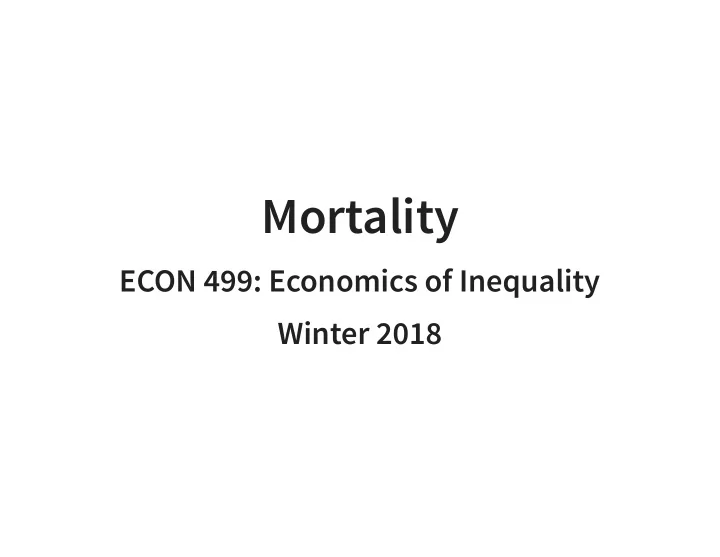

Mortality ECON 499: Economics of Inequality Winter 2018
What are the consequences of inequality? Philosophical debates on inequality are hard to resolve Can instead focus on outcomes Does inequality make people worse o ff in an objective way?
Chetty et al (2016) The Association Between Income and Life Expectancy in the United States, 2001-2014
Life expectancy Calculate the mortality rates for the cross section of every age Use the mortality rates to calculate life expectancy at any given age Alternatively, calculate the percentage of people who survive to a given age Compare that to the distribution of income at each age
Life expectancy and income Men in the top 1% live 14.6 years longer than men in the lowest 1% Women in the top 1% live 10.1 years longer than women in the lowest 1% Gap between men and women lower at high incomes How has this changed over time?
Change in life expectancy Life expectancy across most income groups growing Growing slowly for people low in the distribution, higher for the wealthy Poorest 5% do not appear to be living longer at all
Geography and mortality There are large geographic variations in mortality rates Low-income people die more frequently in the rust belt, midwest, south, and southeast High-income people in coastal areas living longest
Causes Geographical variation allows to compare other geographical outcomes Calculate correlation between life expectancy in bottom quartiles and local characteristics Use top quartile and bottom quartile (top 25%, lowest 25%)
Bottom quartile Top quartile
Bottom quartile Top quartile
Bottom quartile Top quartile
Bottom quartile Top quartile
Bottom quartile Top quartile
Bottom quartile Top quartile
Mechanisms We've only described correlations, not causation Public policy (smoking bans, public services, etc) Peer e ff ects—wealthier, healthier neighbors may induce healthy behavior Compositional/sorting
Case and Deaton (2015, 2017) Rising morbidity and mortality in midlife among white non-Hispanic Americans in the 21st century (2015) Mortality and morbidity in the 21st century (2017) Look at mortality by race and gender instead of income
'Deaths of despair' are cutting life short for some white Americans
All-cause mortality, ages 45-54
Mid-life mortality Deaths due to drug and alcohol poisoning, suicide, and liver disease are increasing for all age groups of non-Hispanic white men For middle-age, it has increased enough to reduce overall life expectancy
Causes Income highly correlated with mortality Cannot explain everything, income for whites shows similar patterns as other groups Case and Deaton suggest "cumulative deprivation" (fewer prospects in life)
Summary Income is highly correlated with life expectancy Increasing inequality increases the gap in mortality between rich and poor For some groups (non-Hispanic white men) life expectancy is decreasing The same people who are losing jobs to trade and automation? How do these people vote?
Recommend
More recommend